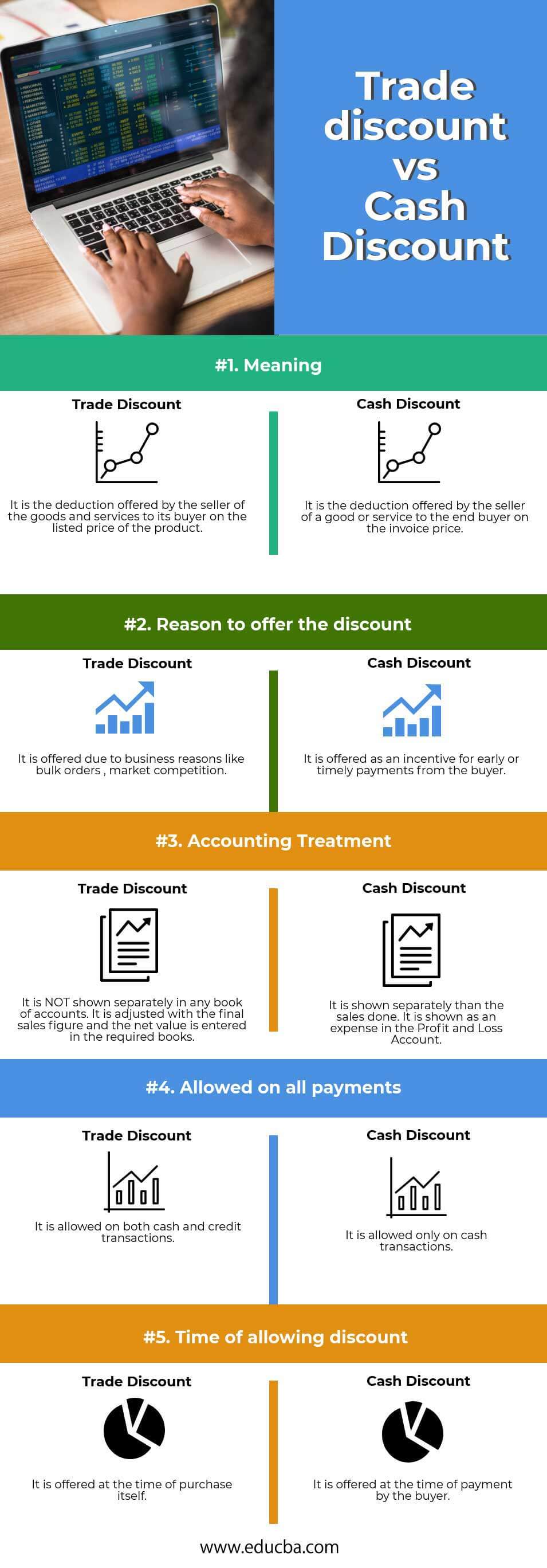Updated July 31, 2023
Difference Between Trade Discount vs Cash Discount
Trade discount is a discount granted by the seller of the goods to the buyer on the list price or catalog prices of the goods supplied, mostly in case of bulk sales. E.g. a wholesaler with a high volume purchase will get a 30% of trade discount. In comparison, a medium volume wholesaler might get a 20% of trade discount; on the other hand, a cash discount, similarly, is referred to as the discount granted by the seller of the goods to the buyer on the invoice price of the company. A cash discount is offered mostly to facilitate prompt payment from the buyer. E.g., if the invoice is due to be paid by the buyer in 20 days, and the payment is made within 10 days, the seller can offer a cash discount of 5% to the buyer on the invoiced price.
Head To Head Comparison Between Trade Discounts vs Cash Discounts (Infographics)
Below is the top 5 difference between Trade Discount vs Cash Discount:
Key Differences Between Trade Discount vs Cash Discount
Both Trade Discounts vs Cash Discounts are popular choices in the market; Let us discuss some of the major differences between Trade Discounts vs Cash Discounts:
Meaning
Every company offers trade and cash discounts to increase sales revenue and attract more buyers. Trade discounts are more prominent in business-to-business transactions, where the buyers are usually wholesalers who prefer buying in bulk quantities. On the other hand, cash discounts are offered to any buyer who makes the payments on time.
Price
The seller offers a trade discount on the list price or the catalog price that the buyer sees at the time of purchase. The seller reduces the list price by a certain percentage based on the quantity purchased. Additionally, the seller offers a cash discount to the buyer on the invoice or billed price of the goods and services. The billed price is the final price at which the product is invoiced, and the buyer must pay it.
The Timing of the Offer
Since the trade discount is decided based on the quantity the buyer purchases, it is offered only at the time of purchase. This sale can, however, be cash or credit sales for the company. Whereas, in the case of a cash discount, a bill is already generated, but if the payment is made much ahead of the payment date, some discount percentage is offered on this billed or invoice rate. Hence, the cash discount can be offered only on cash sales.
Accounting Treatment
The company adjusts trade discounts with the sales prices and, as a result, does not show them separately in any books of company accounts. However, cash discounts, which are provided after the time of sales, are shown as an expense in the Profit and Loss statement of the company.
Example
ABC purchased goods worth $1,00,000 from company X on April 1, 2013. X allowed ABC a 10% trade discount since a bulk purchase is made. Therefore, the sales amount is $90,000 for Company X. Further, the same $90,000 was to be paid by ABC by June 30, 2013. However, ABC paid the entire amount of $90,000 by June 2, 2013. Since it was an early payment, company X offered a cash discount of $5000; therefore, the payment made by ABC was $85,000 only. This $5,000 also becomes an expense for X. In short, a sale was made for $90,000, against which it received Cash of $85,000 and expenditures of $5,000.
Trade Discount vs Cash Discount Comparison Table
Let’s look at the top 5 Comparison between Trade Discounts vs Cash Discount.
| Basis Of Comparison | Trade Discount | Cash Discount |
| Meaning | The seller of the goods and services offers a deduction to its buyer on the product’s listed price. | A good or service seller offers a deduction to the end buyer on the invoice price. |
| Reason to offer the discount | The seller offers it for business reasons such as bulk orders and market competition. | The seller offers it as an incentive for early or timely payments from the buyer. |
| Accounting Treatment | It is NOT shown separately in any book of accounts. Instead, the seller adjusts it with the final sales figure and enters the net value in the required books. | It is shown separately from the sales made. The business shows it as an expense in the Profit and Loss Account. |
| Allowed on all payments | The seller allows it on both cash and credit transactions. | The seller allows it only on cash transactions. |
| Time of allowing a discount | It offers at the time of purchase itself. | It offers at the time of payment by the buyer. |
Conclusion
Trade discounts vs Cash discounts are two common methods companies use to attract wholesale buying and timely payment by buyers and consumers. The end motive is to generate and increase considerable sales revenue over time. These act as primary tools to achieve this goal. However, these discounts offered also have a downturn with them. Trade discounts would mean more and more sales on credit. A good amount of risk would be attached to it for a timely recovery. Cash discounts will start reducing the business’s profit margin since they are an expense shown in the books.
Recommended Articles
This has guided the top difference between Trade Discounts and Cash Discounts. Here, we also discuss the Trade Discount vs Cash Discount key differences with infographics and a comparison table. You may also have a look at the following articles to learn more.





